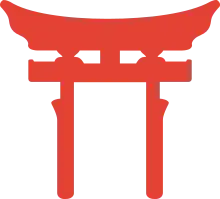Arahitogami
Arahitogami (現人神) is a Japanese word meaning a kami (or deity) who is a human being. It first appears in the Nihon Shoki (c. 720) as a words of Yamato Takeru saying "I am the son of an Arahitokami".[1]
| Part of a series on |
| Shinto |
|---|
 |
| Practices and beliefs |
| Shinto shrines |
| Notable Kami |
| Important literature |
|
| See also |
In 1946, at the request of the GHQ, the Shōwa Emperor (Hirohito) proclaimed in the Humanity Declaration that he had never been an akitsumikami (現御神), divinity in human form, and claimed his relation to the people did not rely on such a mythological idea but on a historically developed family-like reliance. However, the declaration excluded the word arahitogami.
Difference between akitsumikami and arahitogami
Akitsumikami is often translated as "divine" or "divinity", but some Western scholars (including John W. Dower and Herbert P. Bix) explained that its real meaning is "manifest kami" (or, more generally, "incarnation of a god"), and that therefore the emperor would still be, according to the declaration, an arahitogami ("living god"), although not an akitsumikami ("manifest kami"). Jean Herbert explains that, according to the Japanese tradition, the figure of the emperor would be "the extension in time" of the goddess Amaterasu and the previous emperors, representing a naka ima (中今?). Consequently, it would be inadmissible to deny its divine origin.[2]
Note
- Nihon Shoki, Chapter 7
- Herbert, Jean (1964). Aux sources du Japon: Le Shinto. Parigi: Albin Michel.